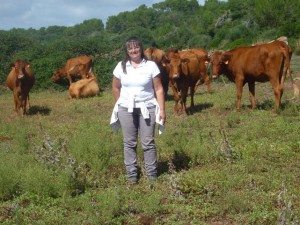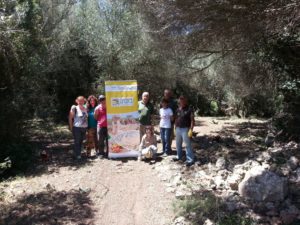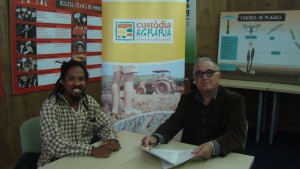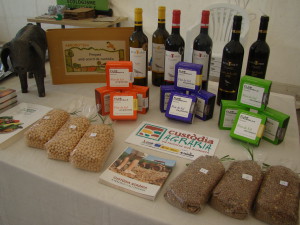Views: 944
Why a Land Stewardship Scheme?
The second line of human activity along the coast, situated just inland behind the tourist areas and traditional seaside population centres, is concentrated on land which, until the last few decades, maintained traditional farming methods, making the countryside of high cultural and biological value.
The arrival of tourism and the attendant frenetic building meant the abandonment of progressive economic agricultural activity along this fringe of land dotted with areas of farming and intensive stockbreeding.
As a result, the land deteriorated. There was homogenization of the countryside, destined for the building of infrastructures, as well as negative environmental effects to the land, to the vegetation, aquifers, watercourses and biodiversity. These had been areas of human population for thousands of years which were now seriously altered affecting not only the quality of life for the local people but also tourism.
There are enormous challenges for public politics concerning rural Spain. The difficulty of competition in a globalized world where there are major tourist attractions in other countries, and the low social prestige of the primary sectors of the economy (making use of natural resources) represent problems which are difficult to surmount.
The Land Stewardship Scheme works to involve all private owners and farmers to make a network of sustainable farming. Owners and managers of the agricultural areas, now or in the future, can incorporate responsible management of their land and give each other support by the exchange of ideas with those who have Land Stewardship agreements.
The Land Stewardship Scheme aims to reinvigorate those people who have been affected by the problems described but can now activate the key to change by bringing awareness of the importance of good maintenance of the land on which they live.
The conservation of the countryside, the positive effects of biodiversity and the environmental services which come from those farms that have signed up to the Land Stewardship Scheme, are of great social value. They promote different products and new commercial methods; they exchange experiences and involve volunteer help…in other words, they are able to make new social alliances extending, also, to persuading public initiatives to become involved in the responsible maintenance and regeneration of the coastal agricultural land.
The final object is to look at the impact of social, environmental and economic sustainability on the agricultural activities along the coast, so they can survive in an inherently dynamic market.

What are the challenges confronting us?
- Environmental challenges: we need to deal directly with land degradation and the homogenization of the countryside. We need to find management strategies that regain the farming sector’s multifunctional ability for maintaining biodiversity, the good condition of the land and the aquatic ecosystems.
- Cultural challenges: avoid the loss of local cultural characteristics and make use of them wherever possible; recognise the position of women in rural countryside and stop the loss of agrobiodiversity (ancient breeds, local varieties).
- Social challenges: we need to increase the prestige of the farming sector based on the commitment of responsible management of the land, the improvement of working conditions, the sponsoring of the young and the promotion of new employment opportunities in agriculture and stockbreeding. At the moment, the number of people who work in agriculture represents only 2.74% of the population which is a great difference from the number working in the service sector which represents 71.48% of the population.
- Economic challenges: make farming profitable so as to reduce the amount of non-productive land; look for a redeployment of farming methods for mechanisation so as to reduce costs; promote marketing channels with the highest profit margins; find new niche markets for produce of farms with Land Stewardship Schemes. The figures for economic growth of the agricultural sector affecting the Gross Domestic Product from Alt Empordá and Menorca is 4.7% and 1.7% respectively, values that do not reflect the strategic power of those who manage 80% of the land in these areas.

Why do we use the Land Stewardship Scheme?
The scheme is defined by the combination of strategies and legal techniques used by property owners and land workers, in conservation and making the best use of the land´s natural values and resources, the culture and landscape.
It works by a method of cooperation, by means of which voluntary agreements are made after a process of dialogue. The project builds bridges of understanding and works together with managers, property owners and farming companies, so that they can join together and with others, to find a common ground based on the principles mentioned.
It forms part of a process already put into effect, carried out with the participation of the farming community that identifies the best ways for achieving environmental and economic benefits. These are the measures that are promoted for application by farms wishing to sign up for the land stewardship scheme.
The project tries to raise the social standing of those proprietors or farm managers, who, as well as producing food and other products are specially committed to conservation. Once signed up, they work jointly with the public as the consumers of their products, with volunteer activities, with training, with education and help from a different point of view.

What strategies do we have?
- To encourage taking up Land Stewardship Schemes so that the area of well managed countryside will increase. It deals with making voluntary agreements between farms that have a Land Stewardship Scheme with other farms so that commitments of mutual help can be established.
- To have training days. These include different events to learn the experiences and projects of all involved, especially those concerned with the relationship between farming and the environment. This alliance is very important in finding new opportunities for the farming sector.
- To promote the products of the Land Stewardship Scheme. To publicise and promote the farm products for commercialisation of those with Land Stewardship Schemes so as to make the farms economically viable. Take part in fairs and markets of the area; organize product tastings for the public and have promotions – just some of the strategies used.
- Organise volunteer days. The involvement of the general public in the project is fundamental, and with volunteer days it is possible to give help direct to those farms recognising responsible land management in their work.
- School Education. The land stewardship scheme is explained by environment education activities in schools. In this way the young can learn about farming and all that goes on concerning the produce, the farmers, the countryside and nature…
- To promote and advertise the Land Stewardship Scheme. Through different events both within and beyond the farms, to create awareness about the care of land and to explain the social roles of the managers of farms, and especially that of women.
- To help with sustainable management of the farms. A series of activities is planned to help improve farm management and make the surroundings and landscape better. To restore watering troughs, to install nesting boxes, to help pollination on farms and to get rid of junk, are just some of the ideas.
- To evaluate the environmental effects resulting from the agreement. It is planned to make inventories of the natural resources used by those farms signed up to the scheme to ascertain the environmental effects resulting from the measures taken.

The Farm Shop
This is the way of selling the produce from farms with land managed responsibly. You can visit our shops or contact with farmers.
How is it applied at a local level?
Look at the map and click on a farm location to get more information.
Show Finques amb acord de Custòdia a Menorca in a bigger size


One thought on “Land Stewardship”
Comments are closed.